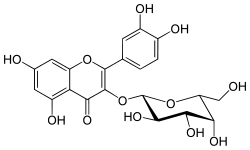Hyperoside
Hyperoside
 |
| Names |
| IUPAC name
2-(3,4-dihydroxyphenyl)-3-[(3R,4S,5R,6R)-3,4,5-trihydroxy-6-(hydroxymethyl)oxan-2-yl]oxy-4H-chromene-4,5,7-triol |
| Other names
Hyperozide
Hyperasid
Hyperosid
Hyperin
quercetin galactoside
Quercetin-3-galactoside
Quercetin-3-O-galactoside |
| Identifiers |
| |
|
| |
|
| ChEBI |
|
| ChemSpider |
|
| ECHA InfoCard |
100.006.892 |
| |
|
InChI=1S/C21H20O12/c22-6-13-15(27)17(29)18(30)21(32-13)33-20-16(28)14-11(26)4-8(23)5-12(14)31-19(20)7-1-2-9(24)10(25)3-7/h1-5,13,15,17-18,21-27,29-30H,6H2/t13-,15+,17+,18-,21+/m1/s1  N NKey: OVSQVDMCBVZWGM-DTGCRPNFSA-N  N NInChI=1/C21H20O12/c22-6-13-15(27)17(29)18(30)21(32-13)33-20-16(28)14-11(26)4-8(23)5-12(14)31-19(20)7-1-2-9(24)10(25)3-7/h1-5,13,15,17-18,21-27,29-30H,6H2/t13-,15+,17+,18-,21+/m1/s1 Key: OVSQVDMCBVZWGM-DTGCRPNFBG
|
c1cc(c(cc1c2c(c(=O)c3c(cc(cc3o2)O)O)O[C@H]4[C@@H]([C@H]([C@H]([C@H](O4)CO)O)O)O)O)O
|
| Properties |
| |
C21H20O12 |
| Molar mass |
464.38 g·mol−1 |
| Density |
1.879 g/mL |
Except where otherwise noted, data are given for materials in their standard state (at 25 °C [77 °F], 100 kPa). |
 N verify (what is N verify (what is  Y Y N ?) N ?) |
| Infobox references |
|
|
Hyperoside is a chemical compound. It is the 3-O-galactoside of quercetin.
Natural occurrences
Hyperoside has been isolated from Drosera rotundifolia, from the Lamiaceae Stachys sp. and Prunella vulgaris, from Rumex acetosella, Cuscuta chinensis seeds, from St John’s wort and from Camptotheca acuminata.[1] It is one of the phenolic compounds in the invasive plant Carpobrotus edulis and contributes to the antibacterial[2] properties of the plant.
In Rheum nobile and R. rhaponticum, it serves as a UV blocker found in the bracts.
It is also found in Geranium niveum[3] and Taxillus kaempferi.[4]
Uses and actions
It can have a protective antioxidant effect on cultured PC12 cells.[5]
Like various other flavonoids, hyperoside has been found to possess antagonist activity at the κ-opioid receptor.[6]
References
- ↑ Li, Shiyou; Zhang, Zhizhen; Cain, Abigail; Wang, Bo; Long, Melissa; Taylor, Josephine (2005). "Antifungal Activity of Camptothecin, Trifolin, and Hyperoside Isolated fromCamptotheca acuminata". Journal of Agricultural and Food Chemistry. 53 (1): 32–7. PMID 15631505. doi:10.1021/jf0484780.
- ↑ Van Der Watt, Elmarie; Pretorius, Johan C (2001). "Purification and identification of active antibacterial components in Carpobrotus edulis L". Journal of Ethnopharmacology. 76 (1): 87–91. PMID 11378287. doi:10.1016/S0378-8741(01)00197-0.
- ↑ Calzada, F; Cerda-García-Rojas, CM; Meckes, M; Cedillo-Rivera, R; Bye, R; Mata, R (1999). "Geranins a and B, new antiprotozoal A-type proanthocyanidins from Geranium niveum". Journal of Natural Products. 62 (5): 705–9. PMID 10346950. doi:10.1021/np980467b.
- ↑ The constituents of Taxillus kaempferi and the host, Pinus thunbergii. I. Catechins and flavones of Taxillus kaempferi. Konishi T, Nishio T, Kiyosawa S, Fujiwara Y and Konoshima T, Yakugaku Zasshi., February 1996, volume 116, issue 2, pages 148-157 (article in Japanese)
- ↑ Liu, Zhiyong; Tao, Xinyi; Zhang, Chongwei; Lu, Yanhua; Wei, Dongzhi (2005). "Protective effects of hyperoside (quercetin-3-o-galactoside) to PC12 cells against cytotoxicity induced by hydrogen peroxide and tert-butyl hydroperoxide". Biomedicine & Pharmacotherapy. 59 (9): 481–490. doi:10.1016/j.biopha.2005.06.009.
- ↑ Katavic PL, Lamb K, Navarro H, Prisinzano TE (August 2007). "Flavonoids as opioid receptor ligands: identification and preliminary structure-activity relationships". J. Nat. Prod. 70 (8): 1278–82. PMC 2265593
 . PMID 17685652. doi:10.1021/np070194x.
. PMID 17685652. doi:10.1021/np070194x.
|
|---|
| MOR |
- PAMs: BMS-986121
- BMS-986122
|
|---|
| DOR | |
|---|
| KOR |
- Agonists: 6'-GNTI
- 8-CAC
- 18-MC
- 14-Methoxymetopon
- β-Chlornaltrexamine
- β-Funaltrexamine
- Adrenorphin (metorphamide)
- Akuuamicine
- Alazocine (SKF-10047)
- Allomatrine
- Apadoline
- Asimadoline
- BAM-12P
- BAM-18P
- BAM-22P
- Big dynorphin
- Bremazocine
- BRL-52537
- Butorphan
- Butorphanol
- BW-373U86
- Cebranopadol
- Ciprefadol
- CR665
- Cyclazocine
- Cyclorphan
- Cyprenorphine
- Diamorphine (heroin)
- Diacetylnalorphine
- Difelikefalin
- Dihydroetorphine
- Dihydromorphine
- Diprenorphine
- Dynorphin A
- Dynorphin B (rimorphin)
- Eluxadoline
- Enadoline
- Eptazocine
- Erinacine E
- Ethylketazocine
- Etorphine
- Fedotozine
- Fentanyl
- Gemazocine
- GR-89696
- GR-103545
- Hemorphin-4
- Herkinorin
- HS665
- Hydromorphone
- HZ-2
- Ibogaine
- ICI-199,441
- ICI-204,448
- Ketamine
- Ketazocine
- Laudanosine
- Leumorphin (dynorphin B-29)
- Levallorphan
- Levomethorphan
- Levorphanol
- Lexanopadol
- Lofentanil
- LPK-26
- Lufuradom
- Matrine
- MB-1C-OH
- Menthol
- Metazocine
- Metkefamide
- Mianserin
- Mirtazapine
- Morphine
- Moxazocine
- MR-2034
- N-MPPP
- Nalbuphine
- Nalbuphine sebacate
- NalBzOH
- Nalfurafine
- Nalmefene
- Nalodeine (N-allylnorcodeine)
- Nalorphine
- Naltriben
- Niravoline
- Norbuprenorphine
- Norbuprenorphine-3-glucuronide
- Noribogaine
- Norketamine
- O-Desmethyltramadol
- Oripavine
- Oxilorphan
- Oxycodone
- Pentazocine
- Pethidine (meperidine)
- Phenazocine
- Proxorphan
- Racemethorphan
- Racemorphan
- RB-64
- Salvinorin A (salvia)
- Salvinorin B ethoxymethyl ether
- Salvinorin B methoxymethyl ether
- Samidorphan
- Spiradoline (U-62,066)
- TH-030418
- Thienorphine
- Tifluadom
- Tricyclic antidepressants (e.g., amitriptyline, desipramine, imipramine, nortriptyline)
- U-50,488
- U-54,494A
- U-69,593
- Xorphanol
|
|---|
| NOP | |
|---|
| Unsorted | |
|---|
| Others |
- Others: Kyotorphin (met-enkephalin releaser/degradation stabilizer)
|
|---|
See also: Receptor/signaling modulators • Signaling peptide/protein receptor modulators |
Flavonols and their conjugates |
|---|
| Backbone | |
|---|
| Flavonols | Aglycones | |
|---|
Conjugates | | |
|---|
|
- Afzelin (Kaempferol 3-rhamnoside)
- Astragalin (kaempferol 3-O-glucoside)
- Kaempferitrin (kaempferol 3,7-dirhamnoside)
- Juglanin (Kaempferol 3-O-arabinoside)
- Kaempferol 3-alpha-L-arabinopyranoside
- Kaempferol 3-alpha-D-arabinopyranoside
- Kaempferol 7-alpha-L-arabinoside
- Kaempferol 7-O-glucoside
- Kaempferol 3-lathyroside
- Kaempferol 4'-rhamnoside
- Kaempferol 5-rhamnoside
- Kaempferol 7-rhamnoside
- Kaempferol 7-O-alpha-L-rhamnofuranoside
- Kaempferol 3-xyloside
- Kaempferol 7-xyloside
- Robinin (kaempferol-3-O-robinoside-7-O-rhamnoside)
- Kaempferol 3-O-rutinoside
- Sophoraflavonoloside (Kaempferol 3-O-sophoroside)
- Trifolin (Kaempferol 3-O-beta-D-galactoside)
|
|---|
| |
|---|
| |
|---|
|
|---|
|
|---|
| O-Methylated flavonols | Aglycones | |
|---|
Glycosides | of isorhamnetin |
- Narcissin (Isorhamnetin 3-O-rutinoside)
- Isorhamnetin 3-O-glucoside
- Tamarixetin 7-rutinoside
|
|---|
other |
- Azalein (Azaleatin 3-O-α-L-rhamnoside)
- Centaurein (Centaureidin 7-O-glucoside)
- Eupalin (Eupalitin 3-0-rhamnoside)
- Eupatolin (Eupatolitin 3-O-rhamnoside)
- Jacein (Jaceidin 7-O-glucoside)
- Patulitrin (Patuletin 7-O-glucoside
- Xanthorhamnin (Rhamnetin glycoside)
|
|---|
|
|---|
|
|---|
| Derivative flavonols | Aglycones |
- Noricaritin
- Dihydronoricaritin
|
|---|
Glycosides | |
|---|
|
|---|
| Pyranoflavonols | |
|---|
| Furanoflavonols | |
|---|
| Semisynthetic | |
|---|

 . PMID 17685652. doi:10.1021/np070194x.
. PMID 17685652. doi:10.1021/np070194x.